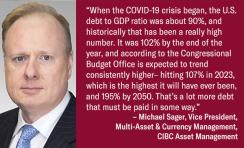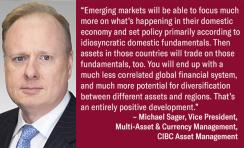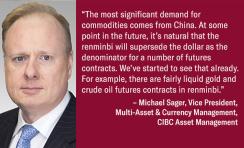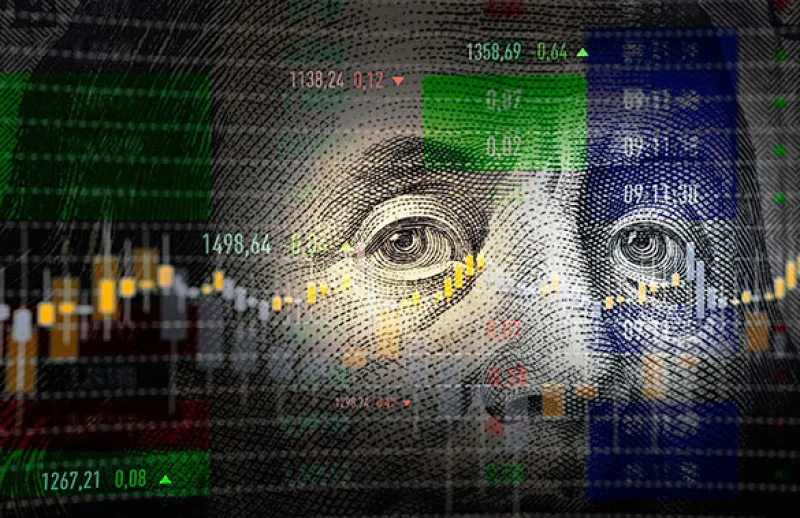The U.S. dollar has enjoyed an eight decades as the dominant currency within the global financial system, but now more than ever that appears set to change. It’s not something you’ll see the full effects of in the immediate future, but the dominance of the dollar is already waning. Incremental change is underway, according Michael Sager, Vice President, Multi-Asset & Currency Management, CIBC Asset Management, and in this conversation with II he explains the reasons why, and what it all means for investors.
When you say the U.S. dollar’s status as the dominant currency globally is waning, what does the timeline look like?
Sager: It’s going to be a gradual trend that plays out in full probably over the next decade – but it has already started. You can see it in key data around payments and foreign exchange reserves. Even though this trend will unfold over the next five to 10 years before gaining real significance, that’s not to say there aren’t already implications for the global economy or global investors.
What happens when the trend, as you say, gains real significance?
Sager: The last 80 years or so has been pretty unprecedented in recent times because the dollar has been the dominant reserve currency. Prior to the start of that run, the status of reserve currencies ebbed and flowed between the dollar, the pound, the French franc, and the deutsche mark. Looking forward, we think there are a variety of reasons that suggest we’ll go back to a multi-currency reserve system where the dollar is just one of several important currencies that will be seen as global reserve currencies. Others will include the euro and renminbi, and to some extent gold.

Why is dollar dominance ebbing?
Sager: There are a number of reasons, some are homegrown in the U.S.; others the results of choices or changes occurring internationally outside the U.S. At home, the Fed has changed its inflation target framework, and now has a built-in institutional bias in favor of slightly more inflation. This makes sense at a time when the U.S. government is issuing a lot more debt, but it’s not great for the prospective strength of the dollar.
When the COVID-19 crisis began, the U.S. debt to GDP ratio was about 90%, and historically that has been a really high number. It was 102% by the end of the year, and according to the Congressional Budget Office is expected to trend consistently higher– hitting 107% in 2023, which is the highest it will have ever been, and 195% by 2050. That’s a lot more debt that must be paid in some way. Higher taxes are not going to be the chosen route for political reasons, nor will a cut in service provisions. That leaves a little bit more inflation to undermine the real value of the debt as the path of least resistance.
Another homegrown contributor to the weakening of the dollar is what [former U.S. Secretary of the Treasury] Hank Paulson called the weaponization of the dollar through a more aggressive use of sanctions and limiting access to U.S. capital markets. I’m not suggesting the use of sanctions is right or wrong, but increased use of them implicitly encourages other countries – other users of the dollars either officially or in the private sector – to find another currency to replace the dollar. That’s already happening. If you look at bilateral trade settlement between China and Russia, for example, five years ago, 90% was settled in dollars. Earlier this year it was down to around about 45%.
What are some of the influences outside the U.S. that are contributing to a weaker dollar?
Sager: The growth of trade within Asia is a big one – particularly Asian countries trading with China – because it signals the relevance of the U.S. economy in the global economy is diminishing, and therefore it’s only natural that the dollar’s status will diminish. Overall, the natural consequences of economic development elsewhere in the world are unavoidable, but they do tend to suggest a less dominant dollar.
Speaking of economic development, how does the trend of a less dominant dollar impact emerging markets?
Sager: Emerging market country policymakers have traditionally had to keep one eye on their domestic economy and the other on what the U.S. is doing. That means that emerging market assets don’t fully trade on domestic fundamentals in the same way as the dollar or euro. If you think about when there are shocks to the global economy, many start in the U.S. and are then transmitted broadly through the global economy and financial system. For example, the global financial crisis started in the U.S., but the dollar strengthened, and the crisis turned into a much bigger problem for European banks and the euro, ultimately leading to the euro-fiscal crisis several years later.
There are many examples of how the U.S. sets policy based primarily on its fundamentals only to have that policy ripple through the global financial system and exert a negative impact on countries that are at a different stage in the global cycle. With a less dominant dollar, the global transmission of shocks will be reduced. That’s the big deal for emerging markets because they will be able to focus much more on what’s happening in their domestic economy and set policy primarily according to idiosyncratic domestic fundamentals. Then assets in those countries will trade on those fundamentals, too. You will end up with a much less correlated global financial system, and much more potential for diversification between different assets and regions. That’s an entirely positive development.

If the dollar’s status is waning, the standing of other some other currencies must be rising. Let’s start with the Euro. Not too many years ago, the Euro was in bad shape. What’s changed, and what more needs to change if the Euro is really to challenge the dollar?
Sager: It was a bit less than 10 years ago when the euro financial crisis was at full throttle, and here we are today expecting the euro will be one of the currencies within a multicurrency reserve system. Two things changed. First, the European Commission recommitted a couple of years ago to promoting the euro forward as a reserve currency. Second, since its inception, the euro and the eurozone lacked a fiscal backbone. In the U.S., a centralized fiscal capability allows for transfers between states. The euro didn’t have that, and the very idea of it was historically anathema to the rich northern states in Europe – but that has changed. At the initial onset of the COVID crisis in early 2020, France and Germany jointly announced creation of a European Recovery Fund, ostensibly designed to help countries recover from the impacts of economic lockdowns. This fund will foster transfers from the likes of Germany and France to the poorer, harder hit countries in the south and the east of the EU. It now looks as if the fund will become a persistent feature of the euro and EU. Although the numbers involved are quite small, it’s the precedent and the direction of travel that matters, and it has all the appearances of the beginning of a fiscal union.
There’s still a long way to go for the euro. It’s the second-most important currency in terms of cross-border trade settlement, for example, but much of that trade involves euro countries. It’s not like the dollar, which is used for trade settlement even when the U.S. is not involved. But the infrastructure is in place for the euro to make the next steps.
Learn more about preparing your portfolio for the potential of a multi-currency reserve system.
Everyone talks about the renminbi as the long-term rival to the dollar. Where are we in that rivalry?
Sager: Long term, the renminbi is going to be one of the currencies in the expected multicurrency reserve system, and it’s going to be a big one. But it too has a long way to go between now and then. Between 2010 and 2015, the use of the renminbi in Chinese cross-border trade increased a lot, and then it plateaued. There’s a lot more growth to come in that regard, but it will depend on continued improvement in institutional quality in China, and making sure that investors, private sector participants, and other governments are happy to accept renminbi in payment, safe in the knowledge that they can recycle them into other currencies or goods and services whenever they want.
Ultimately, the renminbi’s international status will be pushed forward when that confidence takes hold. Another key development will be when the renminbi becomes the currency of record for a number of commodities. The most significant demand for commodities comes from China. At some point in the future, it’s natural that the renminbi will supersede the dollar as the denominator for a number of futures contracts. We’ve started to see that already. For example, there are fairly liquid gold and crude oil futures contracts in renminbi. We’re starting to see a rivalry there with the dollar. If you look at the behavior of a lot of Asian and commodity related currencies, they seem to be trading much more closely with the renminbi than they were 10 to 15 years ago. Another big push for the internationalization of the renminbi will come from the Belt-and-Road initiative. This is intended to integrate China further into the center of the global economy. China is paying for a lot of infrastructure investment in other countries, including in Asia, Africa, and Europe, to develop the network effects that are so important to the status of a global currency. Ten years from now, having spent trillions on this initiative, it’s hard to imagine China is going to let the U.S. dollar be the dominant currency within that system. It’s almost unthinkable that the renminbi won’t gain greatly from the Belt-and-Road initiative, and this is the most important indicator that it will become more and more relevant in the global system.

What about gold? Do you see its importance in investment portfolios rising in the time frame we’re talking about?
Sager: It’s interesting that central banks have been building gold reserves for a number of years now, having previously reduced their stocks of gold. There is definitely a lot of demand from central banks and governments, as well as private investors, to own gold as an alternative to the U.S. dollar. Gold has got a number of facets going for it over the very long term. It has proven itself as a decent hedge against inflation. If the U.S. and some other governments now exhibit a bias in favor of a little bit more inflation, then having gold in your portfolio as a private investor or a sovereign wealth fund makes some sense.
If you look more broadly at what gold offers to a portfolio, traditionally it’s had a great negative correlation with equities. Equities dominate portfolios. If you can find assets on average which have negative correlation, it’s probably worth having an allocation to them in your portfolio. ETF demand for gold has risen substantially in recent years, along with institutional investor demand. Gold does a lot of good things for an investor. It’s not a perfect asset, and it doesn’t always protect you, but on average it has. It also has great liquidity and no credit risk.
Let’s switch gears from one of the oldest currencies to the newest. Where does private cryptocurrency fit into the discussion of the future of the U.S. dollar?
Sager: You’re right to specify private, because central bank digital crypto is definitely coming, but will really just be another way to utilize fiat money in the same vein of notes, coins, credit and debit cards, and payment apps – a different way of delivering the same asset. Private crypto should be considered separately as an investment asset and as a potential player within a multi-asset reserve system.
As an investment asset, private crypto’s correlation to equity risk is positive, so the opposite of gold. Private crypto has equity-like characteristics. Implied volatility for crypto is around 60% annualized, versus something like 15% for equities or much lower for the dollar. Gold has quite high volatility at around 19%, but nothing compared to private crypto. So, crypto is positively correlated to the cornerstone of investment portfolios – equities – and has very high vol. If there’s a significant place for it in institutional portfolios it probably needs to develop more liquidity. Crypto’s AUM is quite low compared to mainstream assets, but it’s moving in the right direction. We’re more skeptical about private crypto as a safe haven, for the reasons I’ve already mentioned – and we’re definitely not there yet in terms of thinking that it can become a core part of a multi-reserve currency system.
Sum up the main investment implications of your view that we’ll see a less dominant U.S. dollar in years to come.
Sager: We talked about the importance of this change for emerging market assets. In addition, we can highlight two others. First, and in the short term, positioning on the dollar. We are positioned for further weakness. If you go back a few years, everybody recognized that separate from any change in its reserve status, the dollar was overvalued. You couldn’t position short dollars at that time, because there was no catalyst for the dollar to weaken. The U.S. economy relative to trend was the strongest out there, and that strength kept the Fed relatively tight compared to other countries, providing support to the dollar. That has changed. As we moved through the spring and summer of 2020, we began to see an economic recovery focused on China, and for the next few years China will remain the main driver of global economic recovery. In other words, the U.S. is ceding cyclical growth leadership. And now the Fed policy has moved from dollar-supportive to incredibly loose, concurrent to massive debt issuance by the U.S. treasury. Between a current overvaluation, a loss of cyclical growth leadership, and a loose-for-long macro policy, you have a catalyst for the dollar to continue to trend weaker, beyond what we’ve seen already. Add to that a waning of the dollar’s dominant reserve currency status, and you can expect even more depreciation. So, the most immediate actionable implication of our views is that the dollar is overvalued, and as such our multi-asset and currency team at CIBC is positioned with a high conviction for the dollar to trend weaker.
Longer term, the dollar has historically exhibited a contra-cyclical correlation with global growth and risk assets such as equities. As the dollar gradually loses its dominant status, it will become a little bit more correlated to the economic cycle – not fully, but a little bit more. That’s important for any investor with global exposure, for instance in equities, bonds, or alternatives, because you make strategic assumptions about the portfolio implications of the currency risk you inherit with those global assets. If correlations change, this will invalidate those assumptions. This will challenge global investors to really rethink how they approach currency risk within their portfolios.
One last question – you argue that the dollar is likely to weaken more in coming years than is suggested by quantitative models. How do you incorporate that belief into your active currency and multi-asset strategies?
Sager: We have a long pedigree at CIBC Asset Management of actively investing in currencies as an asset class to add value to client portfolios. When we do that, we think about the drivers of currencies from the perspective of both quantitative models and from forward looking fundamental analysis. Both have relevance, both are really important. Quant models provide an emotion-free anchor that allows you to understand which assets today, based on historical fundamentals, are cheap or expensive to fair value. Quant models are a great starting point, they are the foundation of an investment process – but they can’t capture everything. The changing status of the dollar is a pertinent example of when quant models become unsighted, because they are typically not forward-looking. Significant thematic changes over the next five to ten years will only be captured by a quant process gradually. So, you need a way to look forward and think about these changes and integrate these insights into your investment process in a timely manner. That’s why we really focus on the integration of quant models and forward-looking fundamental judgment. The bottom line is that this approach provides a lot more breadth and rigor to an investment process and a much more holistic view of what’s driving assets. This will be a key element of our ability to consistently add value to active currency portfolios.
Learn more about preparing your portfolio for the potential of a multi-currency reserve system.
| For a more in-depth discussion, contact: Vishal Mansukhani, CIBC Institutional Asset Management, vishal.mansukhani@cibc.com |
The views expressed in this interview are the personal views of The Multi-Asset Currency Team and should not be taken as the views of CIBC Asset Management Inc. This interview is provided for general informational purposes only and does not constitute financial, investment, tax, legal or accounting advice nor does it constitute an offer or solicitation to buy or sell any securities referred to. All opinions and estimates expressed in this document are as of the date of publication unless otherwise indicated, and are subject to change. Certain information that we have provided to you may constitute “forward-looking” statements. These statements involve known and unknown risks, uncertainties and other factors that may cause the actual results or achievements to be materially different than the results, performance or achievements expressed or implied in the forward-looking statements.






